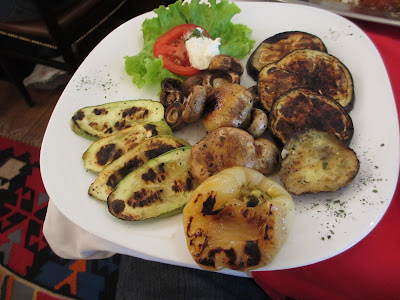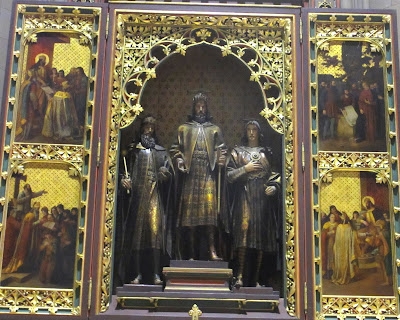Judy and I shared a plate of grilled vegetables and the National plate on a large platter that was recommended (I think they recommend it so that the kitchen can cook volumes of the same thing and push the food out faster). The grilled vegetables were similar to what we had several times elsewhere in the Balkans (obviously what's in season): eggplant slices, a whitish pepper, small mushroom caps, slices of squash (similar looking to zucchini) and a leaf of lettuce with a tomato slice and sour cream. The vegetables were all fresh and cooked and seasoned well.
The National platter for two was huge. It included several filovana paprika, four japrak, several sogan-dolma, Bosanski lonac, four cufta, and the fixings for cevapcici (all described below).
Cufta, or kofta, is a Balkan meatball of minced meat and spices and I believe these were also mixed with vegetables. These were my least favorite of all the items on the plate. They were rather hard, did not have much flavor and did not provide much reason to eat more than a bite or two.
 |
| Cufta |
Bosanski lonac is Bosnian meat stew and consisted of boiled potatoes, carrots, onions, some sort of meat chunks, cabbage, and perhaps other vegetables in a tomato sauce.
 |
| Bosanski Ionac |
Filovana paprika is peppers stuffed with minced meat, rice, tomato, eggs and spices. These peppers appeared white instead of the green or red peppers we normally see.
 |
| Filovana paprika |
Japrak is grape leaves stuffed with rice and meat. The stuffing is predominantly rice and the meat does not modify the taste much from traditional dolma, which is stuffed grape leaves.
 |
| Japrak - similar to stuffed Greek grape leaves, but with meat and rice. |
Sogan-dolma means stuffed onions in Turkish and is a specialty of Mostar. These sogan-dolma appeared to include minced beef, rice, and spices, in addition to the onion. I love these and they went quickly.
 |
| Sogan-dolma |
Cevapcici or cevapi, considered a national dish in Bosina, is Bosnian pita bread (somun) filled with minced lamb and beef that looks like grilled sausages, sliced onions, sour cream, lettuce, and ajvar (an orange colored relish made from red bell peppers, garlic and often eggplant as well). The cevapcici was by far my favorite item and we ate all of it as well. We saw it a number of times in the Balkans. It was usually served with all of the ingredients stuffed in the pita bread. We could not finish much of the rest of the food.
 |
| Cavapcici |
We had the same or similar food on a number of occasions and so we know it was traditional Bosnian, or at least traditional Balkan. Although it was pretty good, it is not the reason to travel to Bosnia. There was nothing that really stood out and cried for more.














































